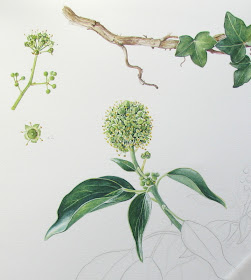"Every leaf speaks bliss to me, fluttering from the
autumn tree." Emily Bronte
Autumn is a visual feast for botanical artists. No season in
all the year is as radiantly glorious as the early autumn, particularly when the weather is as pleasant as it has been this week.
“The time of the falling leaves has come again. Once more in our morning walk we tread upon carpets of gold and crimson, of brown and bronze, woven by the winds or the rains out of these delicate textures while we slept.
How beautifully the leaves grow old! How full of light and color are their last days!”
John Burroughs (The Falling Leaves)
This week, I’ve been busy with a commission, and
whilst painting a non-botanical subject has been a pleasant change, I must
confess to feeling a pang of longing every time I step outside. The beautiful
russets and golds of fallen leaves lie everywhere, and every hedgerow seems festooned
with an abundance of berries and fruit- scarlet, jade, crimson and purple.
Everywhere the delicate green flowers of the ivy beginning to peek out from their glossy coat of green leaves, attracting a host of nectar-hungry insects.
Conkers (the fruit of the Horse chestnut tree Aesculus hippocastanum) are also starting to fall, some still encased in their spikey green coats, whilst
others lie gleaming like polished wood amongst the leaves. I want to pick them up
and bring them all home.
 |
| Conker -Fruit of Aesculus hippocastanum |
As a child, my brothers and I would forage for hours seeking out the biggest, strongest conkers. The chosen conker was threaded onto a
string, and then the conker battles would begin. The idea is to hit your
opponent’s conker and smash it. Some people would ‘cure’ their conker by
putting it in a warm place to harden, but I must confess to cheating and giving
my conkers a secret coat of clear nail varnish.
 |
| Ready for battle! |
|
During the First World War, there was a campaign in which everyone (adults and children), were asked to collect horse-chestnuts, and donate
them to the government. The conkers were used as a source of starch
to produce acetone, which was then used to make the cordite in military
armaments. Conkers were chosen because they are rich in starch but not
edible, Unfortunately the process was not efficient, and the factory closed after a few months. However, it's easy to imagine the happy respite from the horrors of war that this conker-gathering would have brought to families.
|
 |
| Immature magnolia seedpod |
 |
| Rosehips |
 |
| Damson study |
This month a number of my botanical art friends are taking place in
what has become an annual online event, The 30 day Challenge. Every day in the month of September, artists from all over the world have been painting small found treasures, and sharing the images online. I've missed the first two weeks of this year’s challenge, but with such an abundance of Autumn treasures, I’m really tempted to join in for the final flurry. You can read more about the challenge (and also how to take part) on my friend Sigrid Frensen’s blog- http://sigridfrensen.blogspot.ie/2014/09/30-day-challenge.html
 |
| Dianne Sutherland Ball's 30 day Challenge painting is a real feast for the eyes. You can read about the challenge on her blog- http://diannesutherland.blogspot.ie/2013_09_01_archive.html |
"Autumn, the year's last, loveliest smile."
-William Cullen Bryant





The best time of year! I seem to have let the challenge slip though,must catch up! Xxx
ReplyDeleteI'm not surprised, Claire. You've been so busy working on your forthcoming workshop at Denmark Farm, that I'm amazed that you've managed to find time to paint. Best of luck with everything!
Delete